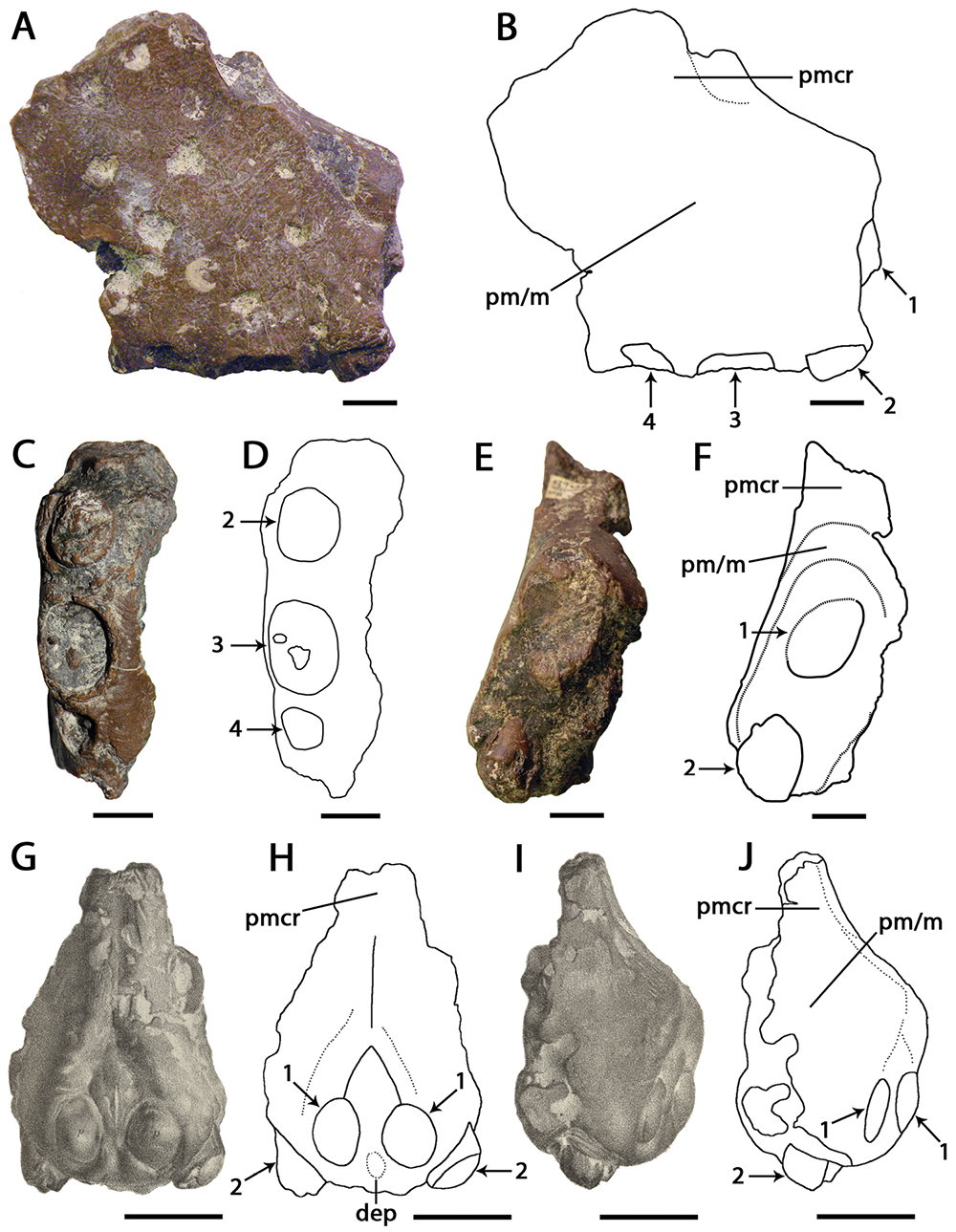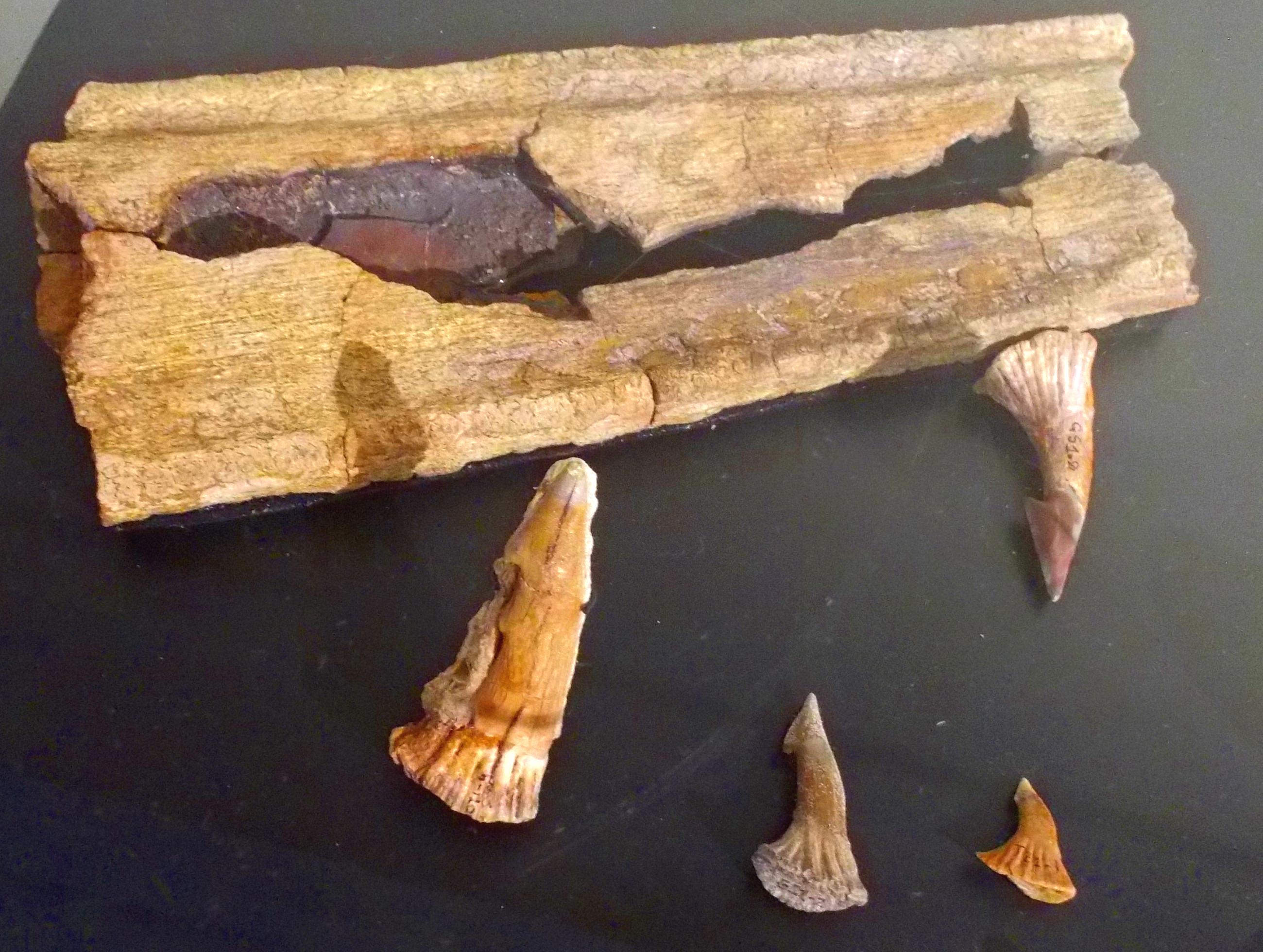|
Nicorhynchus
''Nicorhynchus'' (meaning "knucker snout", in reference to its likely ecology) is a genus of anhanguerid pterosaur from the Cretaceous period. It contains two species, the type species, ''N. capito'', from the Cambridge Greensand of England, and ''N. fluviferox'' from the Kem Kem Group of Morocco. These species were previously assigned to ''Coloborhynchus''. History The genus ''Coloborhynchus'' has had a convoluted history, with many species having been assigned to the genus. In 2013, Rodrigues and Kellner considered ''Coloborhynchus'' to be monotypic, containing only ''C. clavirostris'', and placed most other species in other genera, or declared them '' nomina dubia''. One of these species was ''Coloborhynchus capito'', which was originally named by Harry Seeley in 1870 as a species of ''Ornithocheirus''. Its holotype is CAMSM B 54625, a snout. In 2001, this species was moved to ''Coloborhynchus'' by David Unwin, who also synonymized ''Ornithocheirus reedi'' (known from a lost sp ... [...More Info...] [...Related Items...] OR: [Wikipedia] [Google] [Baidu] |
Nicorhynchus Fluviferox
''Nicorhynchus'' (meaning "knucker snout", in reference to its likely ecology) is a genus of anhanguerid pterosaur from the Cretaceous period. It contains two species, the type species, ''N. capito'', from the Cambridge Greensand of England, and ''N. fluviferox'' from the Kem Kem Group of Morocco. These species were previously assigned to ''Coloborhynchus''. History The genus ''Coloborhynchus'' has had a convoluted history, with many species having been assigned to the genus. In 2013, Rodrigues and Kellner considered ''Coloborhynchus'' to be monotypic, containing only ''C. clavirostris'', and placed most other species in other genera, or declared them ''nomina dubia''. One of these species was ''Coloborhynchus capito'', which was originally named by Harry Seeley in 1870 as a species of ''Ornithocheirus''. Its holotype is CAMSM B 54625, a snout. In 2001, this species was moved to ''Coloborhynchus'' by David Unwin, who also synonymized ''Ornithocheirus reedi'' (known from a lost spe ... [...More Info...] [...Related Items...] OR: [Wikipedia] [Google] [Baidu] |
Coloborhynchus
''Coloborhynchus'' is a genus of pterodactyloid pterosaur belonging to the family Anhangueridae, though it has also been recovered as a member of the Ornithocheiridae in some studies. ''Coloborhynchus'' is known from the Lower Cretaceous of England (Valanginian age, 140 to 136 million years ago), and depending on which species are included, possibly the Albian and Cenomanian ages (113 to 93.9 million years ago) as well. ''Coloborhynchus'' was once thought to be the largest known toothed pterosaur, however, a specimen of the closely related ''Tropeognathus'' is now thought to have had a larger wingspan. History and classification Like many ornithocheiroid pterosaurs named during the 19th century, ''Coloborhynchus'' has a highly convoluted history of classification. Over the years numerous species have been assigned to it, and often, species have been shuffled between ''Coloborhynchus'' and related genera by various researchers. In 1874 Richard Owen, rejecting the creation by H ... [...More Info...] [...Related Items...] OR: [Wikipedia] [Google] [Baidu] |
Coloborhynchus Fluviferox By Nick Longrich
''Coloborhynchus'' is a genus of pterodactyloid pterosaur belonging to the family Anhangueridae, though it has also been recovered as a member of the Ornithocheiridae in some studies. ''Coloborhynchus'' is known from the Lower Cretaceous of England (Valanginian age, 140 to 136 million years ago), and depending on which species are included, possibly the Albian and Cenomanian ages (113 to 93.9 million years ago) as well. ''Coloborhynchus'' was once thought to be the largest known toothed pterosaur, however, a specimen of the closely related ''Tropeognathus'' is now thought to have had a larger wingspan. History and classification Like many ornithocheiroid pterosaurs named during the 19th century, ''Coloborhynchus'' has a highly convoluted history of classification. Over the years numerous species have been assigned to it, and often, species have been shuffled between ''Coloborhynchus'' and related genera by various researchers. In 1874 Richard Owen, rejecting the creation by Ha ... [...More Info...] [...Related Items...] OR: [Wikipedia] [Google] [Baidu] |
Kem Kem Group
The Kem Kem Group (commonly known as the Kem Kem beds) is a geological group in the Kem Kem region of eastern Morocco, whose strata date back to the Cenomanian stage of the Late Cretaceous. Its strata are subdivided into two geological formations, the lower Gara Sbaa Formation and the upper Douira Formation. It is exposed on an escarpment along the Algeria–Morocco border. The unit unconformably overlies Paleozoic marine units of Cambrian, Silurian and Devonian age, and is itself capped by limestone platform rock of Cenomanian-Turonian age. It primarily consists of deltaic deposits. The lower Gara Sbaa Formation primarily consists of fine and medium grained sandstone, while the Douira Formation consists of fining-upwards, coarse-to-fine grained sandstones intercalated with siltstones, variegated mudstones, and occasional thin gypsiferous evaporites. Dinosaur remains are among the fossils that have been recovered from the group.Weishampel, David B; ''et al.'' (2004). "Dinosau ... [...More Info...] [...Related Items...] OR: [Wikipedia] [Google] [Baidu] |
Uktenadactylus
''Uktenadactylus'' is a genus of anhanguerid pterodactyloid pterosaurs from the Lower Cretaceous Paw Paw Formation of Texas, United States and the Wessex Formation on the Isle of Wight, England. Fossil remains of ''Uktenadactylus'' dated back to the Early Cretaceous period (Barremian to Cenomanian stages), from about 125 to 100 million years ago. Discovery and naming In 1994, Yuong Nam-Lee named a new species within the genus ''Coloborhynchus'': ''Coloborhynchus wadleighi'', based on a partial snout found in 1992 in Albian layers in Tarrant County, holotype SMU 73058 ( Shuler Museum of Paleontology, Southern Methodist University at Dallas). The specific name honors the collector of the fossil, Chris Wadleigh. The reference of the species to the genus ''Coloborhynchus'' was based on the fact that both ''C. wadleighi'' and the type species of ''Coloborhynchus'', ''Coloborhynchus clavirostris'', share the trait of having three pairs of teeth laterally placed within a broad snout ti ... [...More Info...] [...Related Items...] OR: [Wikipedia] [Google] [Baidu] |
Cambridge Greensand
The Cambridge Greensand is a geological unit in England whose strata are earliest Cenomanian in age. It lies above the erosive contact between the Gault Formation and the Chalk Group in the vicinity of Cambridgeshire, and technically forms the lowest member bed of the West Melbury Marly Chalk Formation.Cambridge Greensand at BGS It is a remanié deposit, containing reworked fossils of late age, including those of dinosaurs and pterosaurs. Description The lithology is made out of |
Aerodraco
''Aerodraco'' (meaning "air dragon") is a genus of anhanguerid pterosaur from the Albian–Cenomanian-age Cambridge Greensand of England. It contains only one species, ''Aerodraco sedgwickii''. It was originally assigned to the genus ''Pterodactylus''. Discovery and naming In 1859, Sir Richard Owen named pterosaur material from the Cambridge Greensand of England as ''Pterodactylus sedgwickii''.R. Owen. 1859. Supplement (No. I) to the Monograph on the Fossil Reptilia of the Cretaceous Formations. Palaeontographical Society Monographs 1–19 At the time, ''Pterodactylus'' was a wastebasket taxon; all sorts of unrelated pterosaurs were assigned to that genus. In 1870, Harry Seeley reassigned it to ''Ornithocheirus'', another wastebasket taxon. Its specific name honors Adam Sedgwick. It was in 1869 renamed by Seeley into a ''Ptenodactylus sedgwickii'',Seeley, H.G., 1869, ''Index to the fossil remains of Aves, Ornithosauria, and Reptilia, from the Secondary System of Strata arrange ... [...More Info...] [...Related Items...] OR: [Wikipedia] [Google] [Baidu] |
Ferrodraco
''Ferrodraco'' ("Iron Dragon" after the ironstone the fossil was found in) is an extinct genus of anhanguerid pterosaur known from the Late Cretaceous Winton Formation of Queensland, Australia, containing the single species ''F. lentoni''. The species was named after the former mayor of Winton, Graham Thomas ‘Butch’ Lenton. It is the most complete pterosaur fossil from Australia, being known from the holotype specimen AODF 876, consisting primarily of the anterior portion of the skull and dentary, cervical vertebral centra and a partial wing. Its wingspan was estimated to be about . ''Ferrodraco'' was found to have been within the subfamily Ornithocheirinae, as sister taxon to '' Mythunga''. A recent study also recovered ''Ferrodraco'' as sister taxon to ''Mythunga'', but both placed within the family Anhangueridae, more specifically within the subfamily Tropeognathinae. ''Ferrodraco'' is also the latest surviving member of Anhangueria. Discovery and naming The holotyp ... [...More Info...] [...Related Items...] OR: [Wikipedia] [Google] [Baidu] |
Mythunga
''Mythunga'' is a genus of anhanguerid pterosaur from the late Early Cretaceous of Australia. Fossil remains of ''Mythunga'' dated back to the Albian stage of the Early Cretaceous, and the animal itself was found to be a close relative of another Australian anhanguerid called ''Ferrodraco''. Discovery and naming ''Mythunga'' is known from a partial skull, holotype QM F18896 found in April 1991 by Philip Gilmore in marine rocks of the late Albian-age Toolebuc Formation at Dunluce Station west of Hughenden, Queensland. Only the middle snout and corresponding parts of the lower jaws are known, including the rear of a left premaxilla, the lower parts of both maxillae, the rear dentaries and a right splenial. They were three-dimensionally preserved, associated in a chalk nodule. It represents a subadult individual. The fossil was prepared by Angela Hatch of the Queensland Museum, both by mechanical means and by an acid bath. The type species ''Mythunga camara'' was named and descri ... [...More Info...] [...Related Items...] OR: [Wikipedia] [Google] [Baidu] |
Siroccopteryx
''Siroccopteryx'' is an extinct genus of anhanguerid pterodactyloid pterosaur, known from middle Cretaceous (between the Albian and Cenomanian stages, about 105 million years ago) sediments in modern-day Morocco. Some researchers, such as David M. Unwin, consider the genus a junior synonym of ''Coloborhynchus''. Description The genus was named and described in 1999 by Bryn Mader and Alexander Kellner. The name ''Siroccopteryx'' means "wing of the Sirocco", referring to the warm wind that originates in the North Africa and then goes through the Mediterranean, and the Greek word ''pteryx'', a standard suffix for pterosaur genera that means "wing". The epithet of the type species ''S. moroccensis'' refers to its country of origin. This pterosaur is known only from the front part of the jaw with teeth. The holotype fossil, LINHM 016 (Long Island Natural History Museum), was found near Ksar es Souk, in the province of Errachidia in the region of Meknes-Tafilalet at 30.4 ° N, 4 ... [...More Info...] [...Related Items...] OR: [Wikipedia] [Google] [Baidu] |
Tropeognathus
''Tropeognathus'' (meaning "keel jaw") is a genus of large pterosaurs from the late Early Cretaceous of South America. This genus is considered to be a member of the family Anhangueridae, however, several studies have also recovered it within another family called Ornithocheiridae. Both of these families are diverse groups of pterosaurs known for their keel-tipped snouts and large size. ''Tropeognathus'' is regarded as the largest pterosaur found in the Southern Hemisphere, only rivaled by the huge azhdarchids. The type and only species is ''Tropeognathus mesembrinus''. Fossil remains of ''Tropeognathus'' have been recovered from the Romualdo Formation, which is a Lagerstätte located in the Santana Group of the Araripe Basin in northeastern Brazil. Discovery and naming In the 1980s the German paleontology museum '' Bayerische Staatssammlung für Paläontologie und historische Geologie'' in Munich acquired a pterosaur skull from Brazilian fossil dealers that had probably bee ... [...More Info...] [...Related Items...] OR: [Wikipedia] [Google] [Baidu] |
Albian
The Albian is both an age of the geologic timescale and a stage in the stratigraphic column. It is the youngest or uppermost subdivision of the Early/Lower Cretaceous Epoch/Series. Its approximate time range is 113.0 ± 1.0 Ma to 100.5 ± 0.9 Ma (million years ago). The Albian is preceded by the Aptian and followed by the Cenomanian. Stratigraphic definitions The Albian Stage was first proposed in 1842 by Alcide d'Orbigny. It was named after Alba, the Latin name for River Aube in France. A Global Boundary Stratotype Section and Point (GSSP), ratified by the IUGS in 2016, defines the base of the Albian as the first occurrence of the planktonic foraminiferan '' Microhedbergella renilaevis'' at the Col de Pré-Guittard section, Arnayon, Drôme, France. The top of the Albian Stage (the base of the Cenomanian Stage and Upper Cretaceous Series) is defined as the place where the foram species '' Rotalipora globotruncanoides'' first appears in the stratigraphic column. The Albia ... [...More Info...] [...Related Items...] OR: [Wikipedia] [Google] [Baidu] |









